Music theory is all about understanding notes and rhythms to the scales, chords, and progressions that get people hooked.
Plus it helps you learn how to create harmonies, structure melodies, and arrange tracks the right way to take your production skills to the next level.
As producers, knowing all the music theory basics (and advanced techniques) can seriously change the game for you.
That’s why I’m breaking down the absolute best online music theory course in the industry 一 it gives you access to everything you need to know, like:
- How to understand rhythm, time signatures & syncopation ✓
- Mastering major scales, minor scales, and modal scales ✓
- Building functional chord progressions from scratch ✓
- Seventh chords, extended chords, etc. ✓
- How to hear and identify intervals in music ✓
- The Circle of Fifths and how to use it to change key signatures ✓
- Advanced counterpoint, voice leading & harmonic techniques ✓
- How to knock out professional musical compositions ✓
- Writing melodies that sound unique ✓
- Why it’s better than all the other online courses ✓
- Much more about this legendary music theory course ✓
By checking out the best online music theory course, you’ll seriously level up your skills and expand your musical knowledge in a major way.
This way, your tracks will be more dynamic, harmonically on point, and professionally structured every single time.
Plus, you’ll know all about music notation, advanced harmony, and theory techniques just like the professionals.
Table of Contents
The Best Music Theory Course Ever: Unison Songwriting Secrets

If you’re looking for the best music theory course that actually teaches you how to use music theory to make better songs, Unison Songwriting Secrets is it.
This online music theory course, created by Unison Audio, is taught by professional songwriter Drew Kapner.
He breaks down music theory and songwriting in a way that actually makes sense for modern musicians and producers of all levels and styles.
It includes:
- 8 in-depth modules
- Over 5 hours of HD video lessons
- Step-by-step training
It covers everything from rhythm and scales to advanced chords, melodies, and song structure.
Plus, you’ll get PDF cheat sheets, real-life exercises, and song breakdowns 一 making it one of the most complete music theory courses available today.
Download The #1 Music Theory Course EVER
Breaking it Down Module by Module
Now, let’s talk about the modules of this legendary best music theory course so you can see exactly what’s inside. Each section is designed to help you understand, apply, and create music with expert techniques. It’s one of the most complete music theory courses out there, so let’s break it down.
Module 1: Music Theory Made Easy
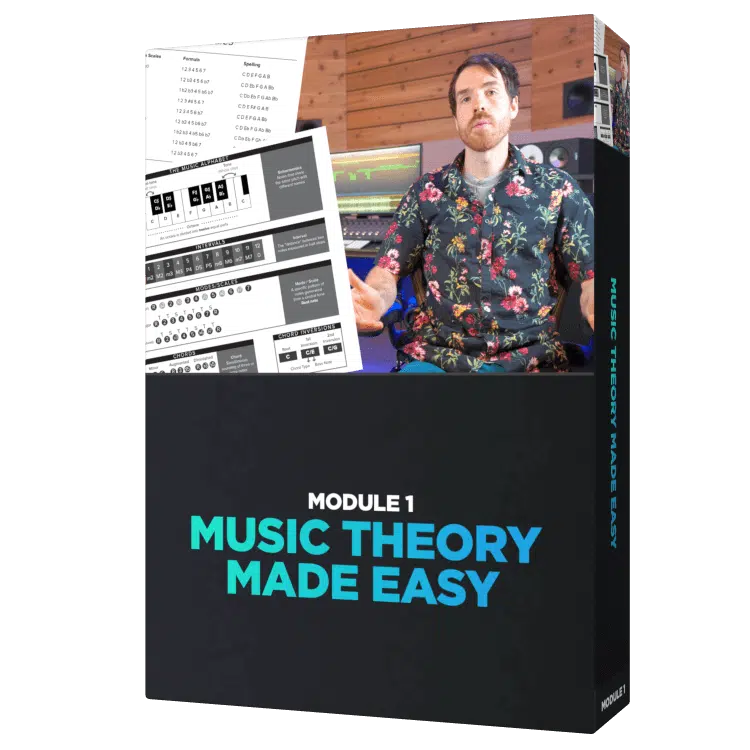
Before you can start writing incredible chord progressions and laying down catchy melodies, you need a solid understanding of music theory.
This module is designed to take the most essential music theory concepts and make them super easy to learn and apply.
All without getting bogged down by useless information.
You’ll learn everything about rhythm, scales, intervals, and the Circle of Fifths, all broken down in a way that actually makes sense for producers, songwriters, and musicians.
Let’s break down this module a little more so you can get a comprehensive understanding of why it’s the top online music theory course in the game.
-
Understanding Rhythm

Rhythm is the foundation of every song, regardless of genre or style.
This music theory course breaks it down by explaining tempo, which is measured in beats per minute (BPM).
A slow 60 BPM track feels chill, while a 140 BPM beat has high energy.
You’ll also learn about different time signatures, like 4/4 (the standard in most music) and 3/4 (common in some R&B songs).
This way you can understand how beats are grouped in different styles.
It also teaches you about syncopation, which is when accents are placed on unexpected beats (think about the groove in funk or offbeat hi-hats in trap music).
By the end of this module, you’ll be able to lock into any rhythm, create your own grooves, and understand how rhythm works in professional music production.
Plus all of the key elements needed to break all the rules as well, which you do not want to miss out on.
-
Mastering Scales

Scales are the DNA of music, and if you don’t understand scales, you’re basically guessing when you make melodies or chords pop.
In this music theory course, you’ll learn music theory in a way that makes sense, starting with:
- The major scale (which creates bright, happy melodies)
- The minor scale (which gives songs a darker, emotional vibe)
You’ll also dive into modal scales, like Dorian (used in funk and neo-soul) and Phrygian (common in trap and Latin music), which add unique flavors to your tracks.
It even explains how scales are built using whole steps and half steps, so you’ll know exactly why certain notes sound good together and why others just… don’t.
A great example is the C major scale (C-D-E-F-G-A-B-C), which has no sharps or flats, versus the A minor scale (A-B-C-D-E-F-G-A), which has a more moody tone.
With this knowledge, you’ll be able to pick the right scale for your song and create melodies that actually fit the vibe you’re going for.
-
Intervals
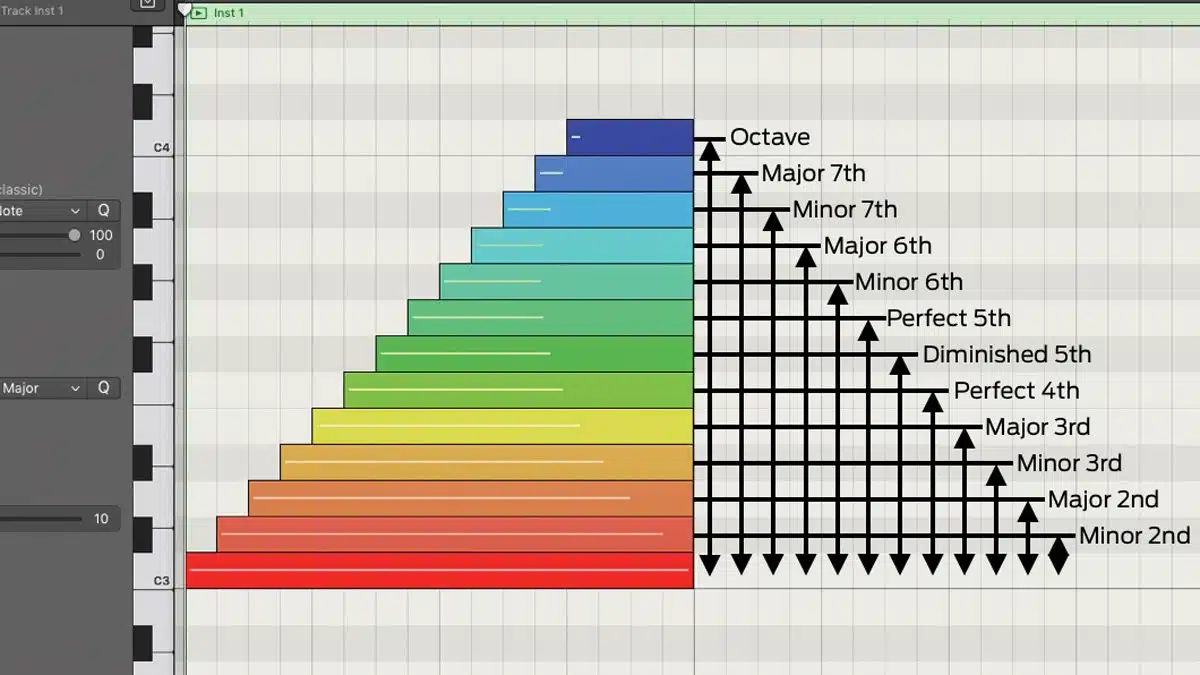
Intervals are the distances between notes, and understanding them is also super important for building melodies, harmonies, and chords.
This music theory course explains:
- Major intervals (which sound bright and happy)
- Minor intervals (which sound more melancholic)
- Perfect intervals (which feel neutral)
- Diminished/augmented intervals (which create tension)
For example, a major third (C to E) is what makes a major chord sound uplifting, while a minor third (C to E♭) gives it a more emotional feel.
It also teaches ear training, so you can hear intervals in real music and instantly identify them by sound, which is a true game-changer.
Once you understand intervals, you’ll have the skills to create killer harmonies, recognize chord tones, and structure your music like a professional musician/producer.
If you were to have a final grade, or personalized feedback after this course, you’d definitely get rave reviews, hands down.
-
The Circle of Fifths
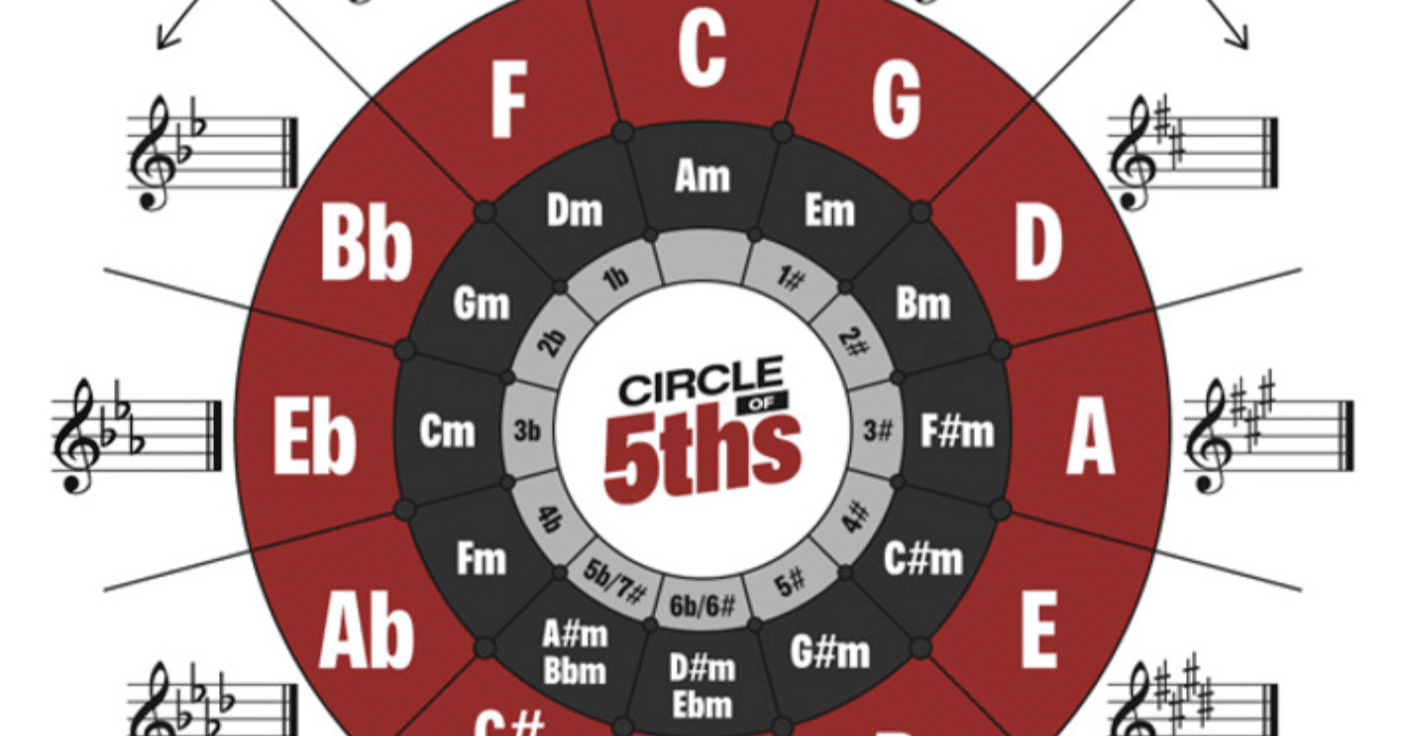
The Circle of Fifths is one of the most powerful tools in music theory, and you certainly need to know it if you want to become a music theory master.
And, if you’ve ever struggled to understand key signatures, chord progressions, or modulation, this part of the music theory course clears it up completely.
The circle is a visual representation of how different keys relate to each other, arranged in a clockwise motion by perfect fifths.
So, C major moves to G major, then to D major, A major, and so on.
You’ll learn music theory concepts like relative minor/relative major relationships…
This means that, for every major key, there’s a minor scale that shares the same key signature (for example, C major and A minor both have no sharps or flats).
It breaks down how to use the Circle of Fifths to create chord progressions that naturally flow 一 making it easier to write smooth transitions between song sections.
For example, if you’re in G major, moving to D major (the next step in the circle) will sound natural, while jumping randomly between unrelated keys might sound awkward.
By mastering the Circle of Fifths, you’ll understand how Western music notation is structured so you can break the rules appropriately.
Remember, music theory is all about learning the rules so you can break them correctly.
It will give you the skills to create more sophisticated compositions and experiment with key changes like a professional musician.
Module 2: Beginner Chords
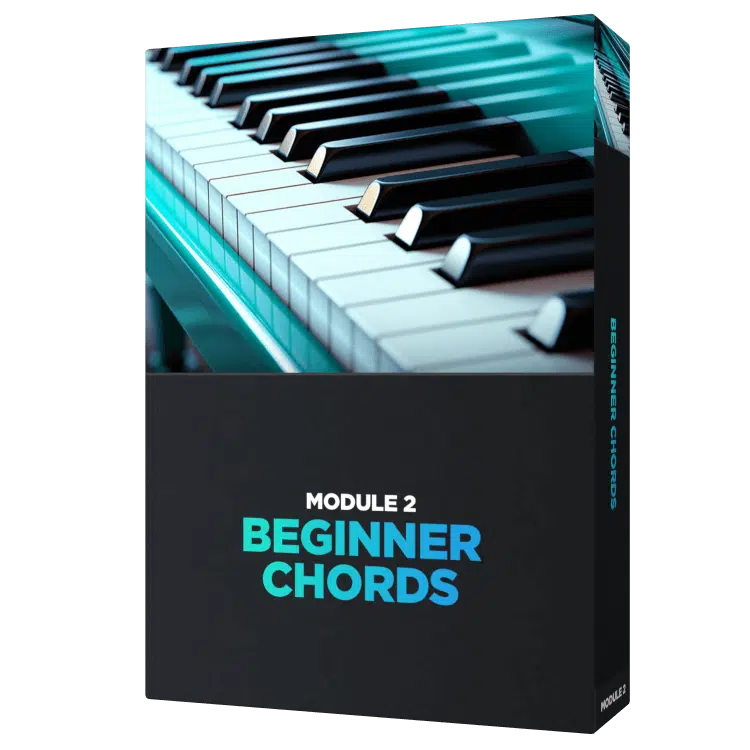
You can’t talk about the best online music theory course and not talk about chords, which are the foundation of harmony in music.
This module teaches you how to build and play chords properly from the very start so you can really knock it out of the park.
You’ll begin by learning how to construct major and minor triads 一 the three-note chords that make up almost every song ever written.
It explains why major chords (like C-E-G) sound happy and why minor chords (like A-C-E) sound sad, giving you the ability to choose the right chords for the emotion you want.
It also covers harmonic rhythm, which is the timing of chord changes in a song…
For example, in a slow ballad, chords might change every two bars, but in an energetic pop song, they could switch every beat.
Another key topic of this module is chord voicings, which means spreading out the notes of a chord differently on an instrument.
For example, playing a C major chord with the notes stacked closely together versus spreading them across different octaves.
Bottom line, after completing this module, you’ll be able to create chord progressions that sound professional, smooth, and emotionally powerful.
Module 3: Intermediate Chords
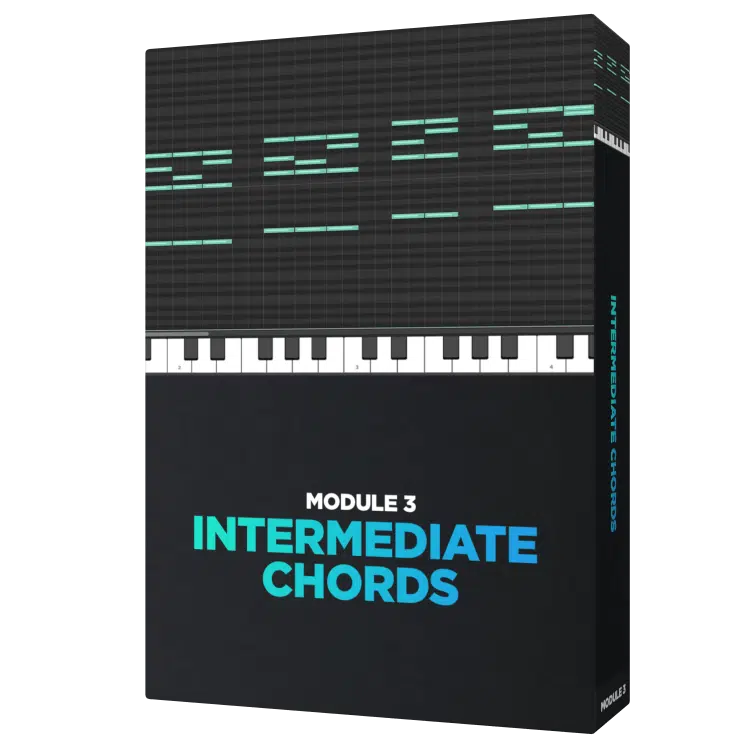
Once you’ve nailed basic triads, this music theory course moves into more complex chord structures that add killer depth to your songs.
You’ll learn about triad inversions, which allow you to rearrange the order of chord tones to create smoother voice leading.
So, instead of always playing a C major chord as C-E-G, you can play E-G-C or G-C-E for a different feel.
It also introduces slash chords, where the bass note is different from the root note of the chord 一 making your progressions sound more interesting.
For example, D/F# means a D major chord with an F# in the bass.
By the time you finish this module, you’ll have the skills to experiment with different chord shapes and make your progressions sound more dynamic.
Plus, confidently build harmonies like a seasoned producer regardless if you’re just starting out or have been in the game for years.
Module 4: Advanced Chords

Once you’ve mastered basic and intermediate chords, this music theory course dives into advanced chord structures that give your music a super professional edge.
You’ll learn about seventh chords, which are built by stacking four notes instead of three 一 creating a richer and more complex harmony.
Like a Cmaj7 (C-E-G-B) for a dreamy feel or a C7 (C-E-G-B♭) for a bluesy sound.
It also covers extended chords to add even more color to your chord progressions, like:
- Ninths
- Elevenths
- Thirteenths
These are used a lot in jazz, R&B, and lo-fi beats to create lush, emotional textures but you can really use them however you’d like (there are no limits).
By the end of this module, you’ll be able to incorporate advanced harmonies into your compositions all day, no matter what vibe you’re looking for.
It will make your music stand out with depth, complexity, and a more unique sound.
Module 5: Memorable Melodies
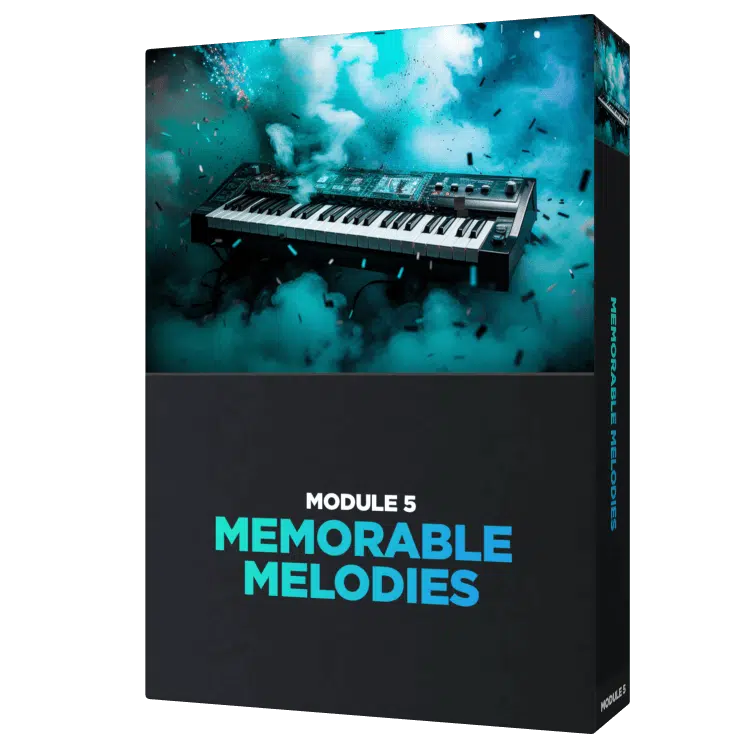
A great melody is what makes a song catchy and unforgettable, and this music theory course also teaches you exactly how to create them from scratch.
You’ll learn about melodic contour, which is the shape of a melody as it moves up and down in pitch.
As well as how different interval choices can completely change the feel of a song.
It also dives into motif development 一 showing how a small, simple musical idea can be repeated, varied, and transformed into a full melody.
Just like how you could flip a short vocal chop into an entire hook.
After completing this module, you’ll be able to write melodies that stick in people’s heads long after your beat ends, whether you’re making pop, hip-hop, EDM, or any other genre.
Module 6: Driving Basslines
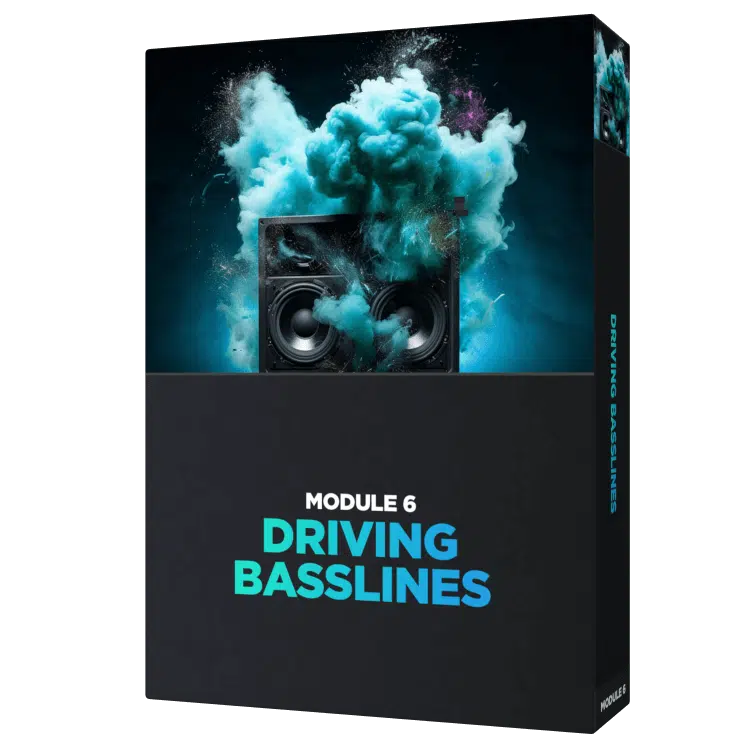
The bassline is what holds the entire track together and can seriously make or break your track if done correctly.
This music theory course is going to break down exactly how to create basslines that support the chords and rhythm while adding movement and groove.
You’ll learn about root note fundamentals, where the bass typically plays the first note of each chord, of course, but also how passing tones and approach notes can be used to make a bassline feel more natural and dynamic.
It also covers syncopation in basslines 一 showing how shifting certain notes slightly off the beat can create a groove that makes people want to move.
By the time you finish this module, you’ll have the skills to create basslines that feel powerful, controlled, and locked into the rhythm of your song.
Seriously, it gives you access to all the secrets to epic, mind-blowing basslines.
Become a Music Theory Master Now
Module 7: Rhythm & Drums
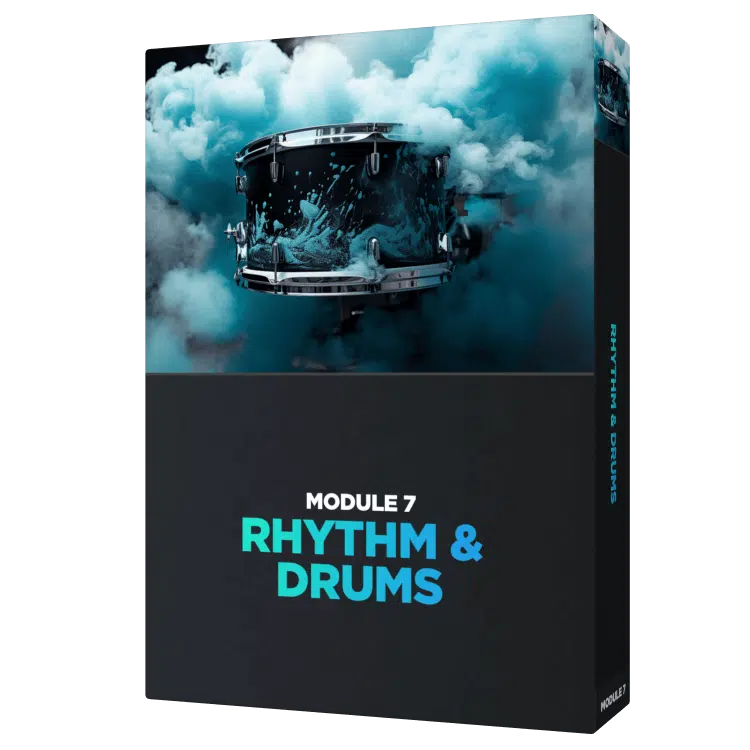
Rhythm is what drives a track forward, and in this online music theory course, you’ll learn exactly how to structure drum patterns.
Ones that lock right into the groove and complement the rest of your song in this almost magical way (can you say top of the charts, anyone?).
It covers different rhythm styles, from straight 4/4 beats (used in pop and rock) to more complex swing grooves (heard in jazz and hip-hop).
This way you can apply them to any musical composition.
You’ll also learn music theory concepts like syncopation, which shifts beats slightly off the grid to create a more dynamic feel.
This is a huge reason why trap hi-hats and funk grooves sound so infectious.
The instructor breaks down how to use ghost notes (lightly played notes that add subtle movement) and polyrhythms (overlapping rhythms that add depth and complexity).
With this information, it’ll make your drum patterns feel more professional.
By the end of this module, you’ll have the skills to create drum rhythms that are tight, interesting, and perfectly matched to your song’s energy.
Module 8: Arrangement
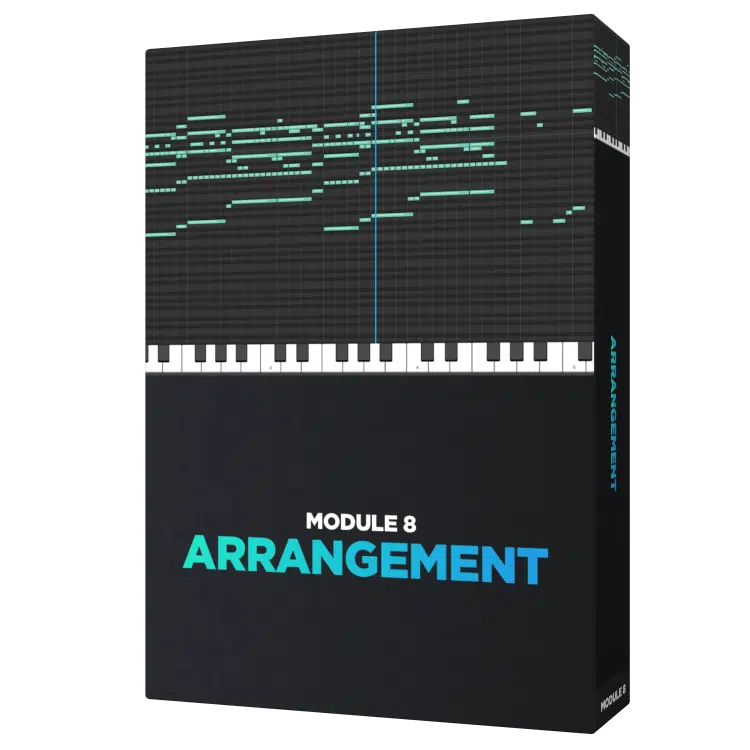
Even if you have great melodies and chord progressions, your song won’t sound complete unless it’s properly arranged.
Luckily, this all-inclusive music theory course teaches you exactly how to do that as well.
You’ll learn how to structure a song from start to finish 一 covering essential sections like intros, verses, choruses, bridges, and outros.
This way, each and every part transitions smoothly into the next like butter.
This music theory course also explains how to use tension and release, such as building energy in a pre-chorus before dropping into a big chorus.
This technique is used in everything from pop hits to EDM drops so needless to say, it can completely enhance your skills.
After this module, you’ll have the skills to structure your songs like a professional musician so they keep listeners engaged from beginning to end.
Advanced Music Theory Tips
Now that you’ve got a solid understanding of the fundamentals, this section of the music theory course dives into more advanced concepts to level up your theory skills and production career. These advanced music theory techniques will help you create better harmonies, more interesting progressions, and unique sound textures that make your music stand out from all the other online courses out there.
-
Functional Harmony & Modulation Techniques
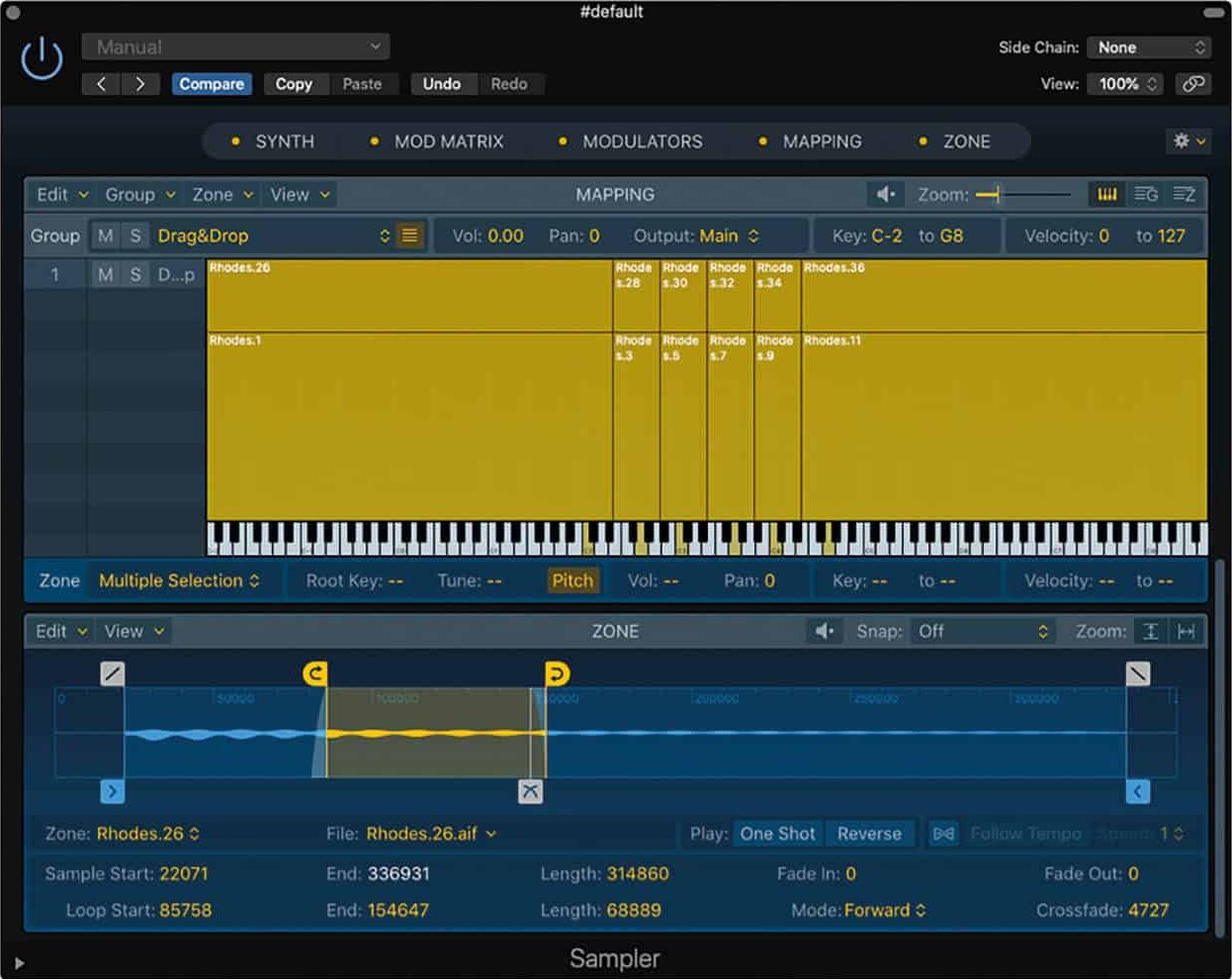
Functional harmony is the backbone of Western music notation, and in this music theory course, you’ll als learn exactly how chord progressions work.
And exactly how to modulate between different keys as well.
It breaks down tonic (I), subdominant (IV), and dominant (V) functions, so you can understand why certain chords create tension and why others feel resolved…
For example, why a V7 chord naturally resolves back to I in almost every pop song in existence (and I’m not even exaggerating).
You’ll also learn music theory techniques like pivot chord modulation, where a shared chord is used to transition smoothly from one key to another.
This trick is used all over R&B, jazz, and cinematic scores to create flawless key changes.
It also covers chromatic modulation, which uses non-diatonic chords (like borrowing from outside scales) to create unexpected but smooth progressions.
After this module, you’ll have the skills to identify, hear, and use functional harmony to make your songs sound more professional and well-structured.
-
Advanced Counterpoint & Voice Leading
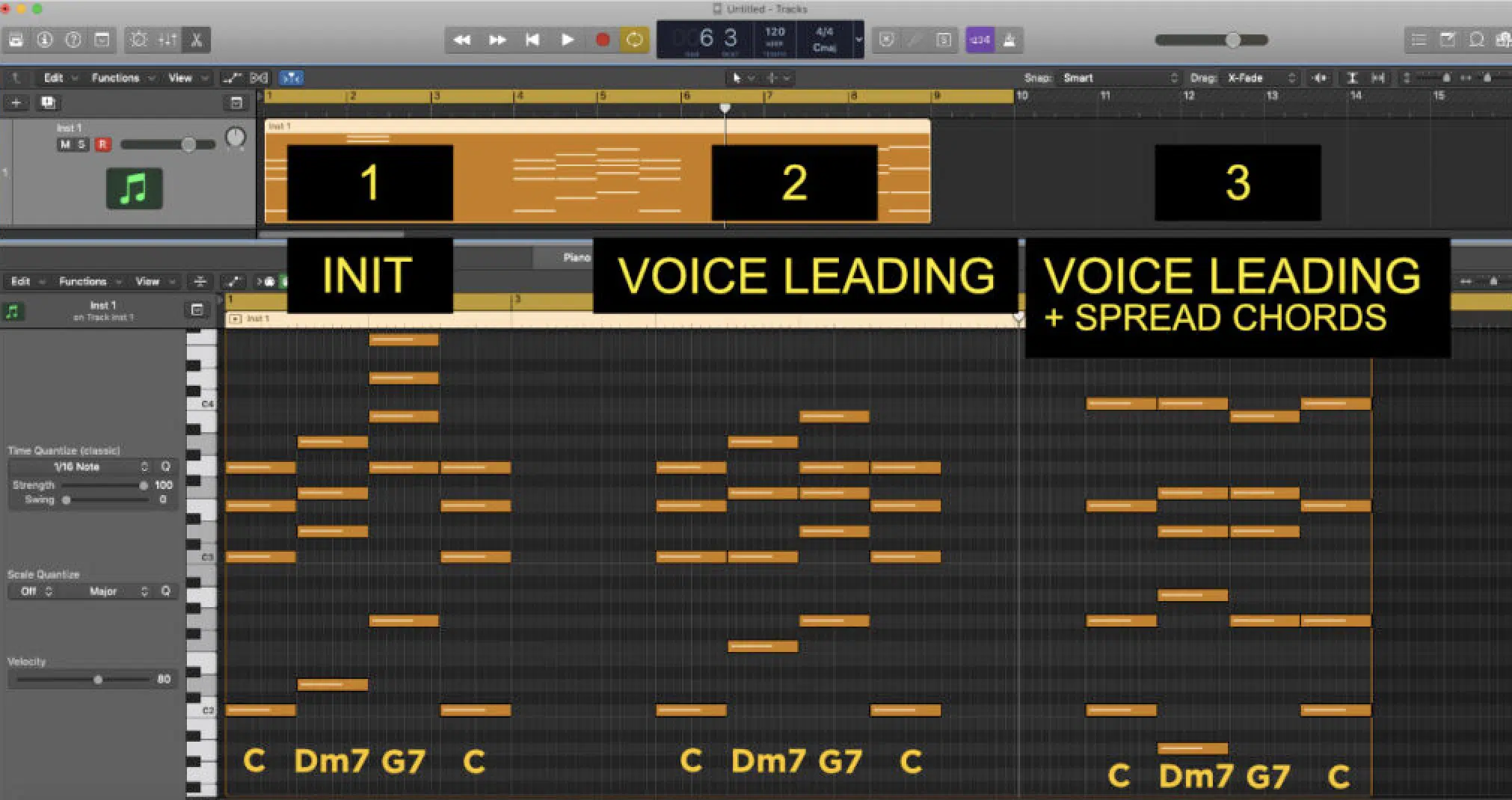
Counterpoint is all about how different melodies move together, and this music theory course teaches you how to create independent melodic lines.
Ones that still harmonize perfectly so you don’t look like an amateur at all.
You’ll learn a specific counterpoint, which explains how one melody interacts with another like layering multiple melodies without clashing.
This epic online music theory course also dives into voice leading.
This one technique that makes chord transitions smoother by moving each note the shortest possible distance.
This is why C major (C-E-G) moving to A minor (A-C-E) sounds so natural.
Another key music theory concept you’ll cover is parallel motion vs. contrary motion, which explains why some progressions feel fluid while others feel static.
By the end of this module, you’ll have the skills to write counterpoint-based melodies, create epic harmonies, and make your chord progressions sound on point.
-
Harmonic Series & Spectral Harmony
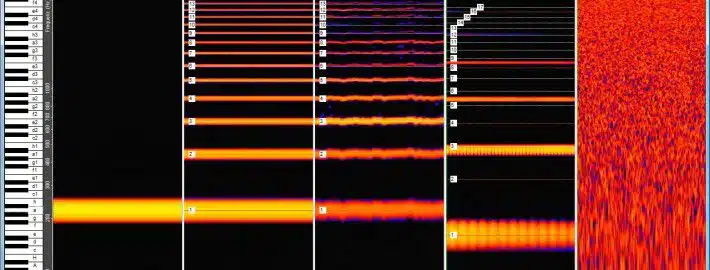
If you’ve ever wondered why certain notes sound good together, the harmonic series holds the answer and this music theory course tells alls.
The harmonic series is a natural phenomenon where higher overtones resonate above a fundamental note, which is why playing C on a piano also subtly produces G, E, and B♭ overtones.
You’ll learn how spectral composers use the harmonic series to build unique chords, textures, and sound design techniques/effects.
It’s essential when you’re working with synths and complex arrangements.
This epic online music theory course also explains overtone-based harmony…
This is why a power chord (C-G) sounds so stable and why a dominant seventh chord (C-E-G-B♭) naturally wants to resolve.
With these advanced music theory skills, you’ll be able to create expert sounds, better harmonies, and use frequency relationships to enhance your mixes/compositions.
-
Seventh Chords
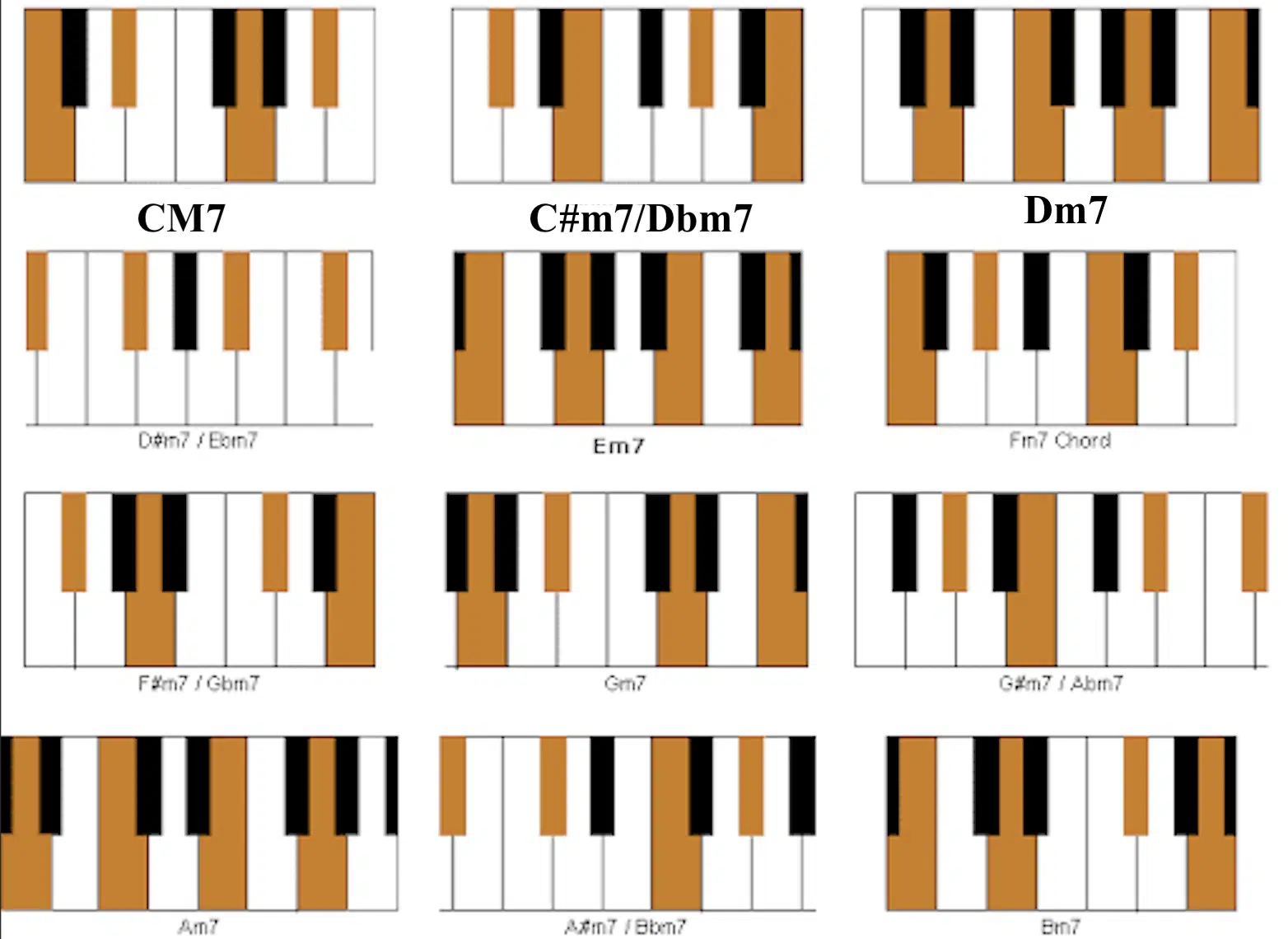
Seventh chords are one of the most important tools in music theory, and this online music theory course gives you access to all the secrets as well.
You’ll learn how to use them to create unmatched depth, tension, and movement.
A seventh chord is made by adding a fourth note on top of a triad, and the course covers all the major types (each with a distinct emotional feel), like:
- Major sevenths (Cmaj7)
- Minor sevenths (Cm7)
- Dominant sevenths (C7)
- Diminished sevenths (C°7)
You’ll also learn how seventh chords create natural voice leading, meaning they can flow into each other smoothly.
For example, how G7 (G-B-D-F) leads perfectly into C major (C-E-G) in a II-V-I jazz progression.
It also covers seventh chord inversions so you can see how to rearrange the notes to make your progressions sound more sophisticated and unique.
You’ll be able to recognize, identify, and create seventh chords like an absolute boss.
Final Thoughts
Bottom line, this legendary music theory course can completely transform the way you understand and create music.
It will show you everything you need to know, from building solid chord progressions and writing memorable melodies to advanced harmony, modulation, and song structure.
Plus everything in between you’d need to master theory (and break the rules effectively).
You’ll be able to successfully identify key signatures, create tension and resolution in your tracks, and arrange complete songs with confidence.
As well as knockout professional-sounding beats and use complex music theory concepts flawlessly, just like the professionals do.
Trust me, you do NOT want to miss out on this one.
It’s packed with game-changing knowledge, designed for real-world application, and unmatched when it comes to creativity and secrets.
So, go check it out and I guarantee you’ll thank me later.
Until next time…
Learn All the Best Theory Secrets Now!







Leave a Reply
You must belogged in to post a comment.